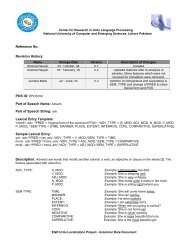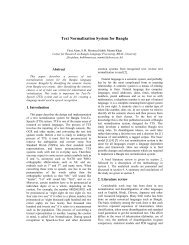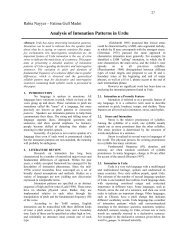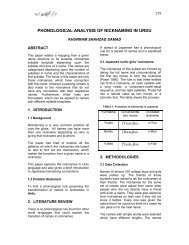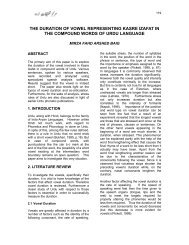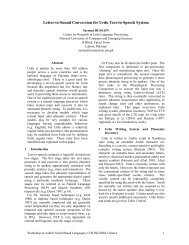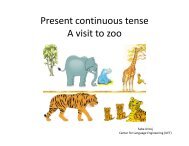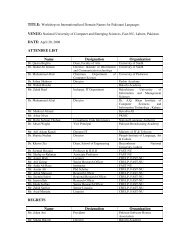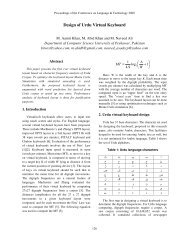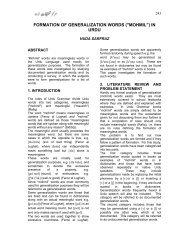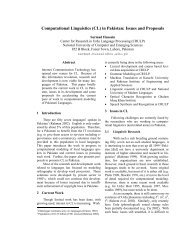ules are better expla<strong>in</strong>ed <strong>in</strong> other than one e.g. assimilationis better described <strong>in</strong> l<strong>in</strong>ear phonology while dissimilation<strong>in</strong> geometric phonology (Napoli, 1996, p.99).Apart from phonological rules, some otherdescriptions <strong>in</strong>clude there is a period <strong>of</strong> voicelessness afterthe articulation <strong>of</strong> stop, dur<strong>in</strong>g this period a burst <strong>of</strong> aircomes out <strong>in</strong> aspirated stops (Hussa<strong>in</strong> & Nair, 1995).One <strong>of</strong> the theories regard<strong>in</strong>g the aspiratedcont<strong>in</strong>uants <strong>of</strong> <strong>Urdu</strong> is that they require more articulatoryeffort and hence they are replaced by the cont<strong>in</strong>uantfollowed by /h/ e.g. /d.la/ becomes [dl.ha], <strong>in</strong> thiscase feature <strong>of</strong> aspiration is lost and is promoted to /h/consonant and the word is re-syllabified. (Nisar & Baqir,2003). Aga<strong>in</strong> there is no <strong>in</strong>dication <strong>of</strong> multiple aspiratedsonorant consonants.3. PROBLEM STATEMENT<strong>Multiple</strong> aspirated consonants occur <strong>in</strong> a s<strong>in</strong>gle<strong>Urdu</strong> word. What phonological rules are followed byaspirated consonants occurr<strong>in</strong>g <strong>in</strong> either adjacent syllablesor different syllables <strong>of</strong> an <strong>Urdu</strong> word?4. METHODOLOGYOver 255 words conta<strong>in</strong><strong>in</strong>g multiple aspiratedconsonants were collected from the <strong>Urdu</strong> dictionary “Ferozul-loghat<strong>Urdu</strong> Jadeed New Edition”. They weretranscribed both phonemically and phonetically. In order toremove ambiguities, these words were searched <strong>in</strong> otherdictionaries like “Farhang-i-Asafiyyah” and “Nur-ul-Lughat”, f<strong>in</strong>al analysis was done on words found <strong>in</strong> at leasttwo <strong>of</strong> these dictionaries. So after remov<strong>in</strong>g ambiguities,over 80 words conta<strong>in</strong><strong>in</strong>g multiple aspirated consonantsseparated by vowel or other consonants were analyzed e.g./p.pudi/ while over 70 words conta<strong>in</strong><strong>in</strong>g aspiratedconsonants adjacent to each other were analyzed e.g./pt.tr/ etc. The English translation <strong>of</strong> these wordswas adopted from “Kitabistan’s Twentieth-CenturyStandard Dictionary”.Apart from words conta<strong>in</strong><strong>in</strong>g multiple aspiratedconsonants, some words conta<strong>in</strong><strong>in</strong>g an aspirated consonantalong with its un-aspirated counterpart were collected <strong>in</strong>order to have better understand<strong>in</strong>g e.g. /b.bk/ etc.When the data had been gathered, it was used <strong>in</strong>sentences <strong>in</strong> such a way that it always came <strong>in</strong> the middle <strong>of</strong>sentences, attempt<strong>in</strong>g to hide the actual problem. Nativespeakers were <strong>in</strong>terviewed regard<strong>in</strong>g the phoneticrepresentation <strong>of</strong> these sentences i.e. word and its carrierphrase but it was observed that if speakers were provideddata <strong>in</strong> written form and then asked to pronounce it, theypaid attention to its written form and tried to utter as muchas possible accord<strong>in</strong>g to orthography, especially <strong>in</strong> case <strong>of</strong>those words that are not commonly used, hence it wasn’ttotally reliable. Along with this it was also judged bylisten<strong>in</strong>g to native speakers day-to-day normal conversationthat is unconscious and hence more reliable.555. RESULTSThe analysis <strong>of</strong> the data showed that <strong>Urdu</strong> wordsdon’t conta<strong>in</strong> multiple cont<strong>in</strong>uant aspirates. Only twowords were found that conta<strong>in</strong>ed cont<strong>in</strong>uant aspirate /l/multiple times <strong>in</strong> their phonemic representation which are/l.l/ and /kl.l/ and they become [ l.l] and[ kl.l] respectively. <strong>Urdu</strong> words have only aspiratedstops and affricates (Appendix A). Most <strong>of</strong> the words havesimilar aspirated consonant rarely dissimilar.Regard<strong>in</strong>g, phonological rules, deletion anddissimilation are very common. Metathesis is quite rarewhile assimilation; epenthesis and compensatorylengthen<strong>in</strong>g are absent.5.1 DeletionAnalysis <strong>of</strong> data showed that aspiration is deletedfrom aspirated consonant, word medially and word f<strong>in</strong>ally.Aspiration is never deleted at beg<strong>in</strong>n<strong>in</strong>g <strong>of</strong> word.At word f<strong>in</strong>al position it is always deleted i.e. atcoda position <strong>of</strong> last syllable e.g. / tja.s/ becomes[tja.s]. [+aspirated]Rule 1. Deletion <strong>of</strong> aspiration from aspirated consonant atword boundary <strong>in</strong> words. “#” represents word boundary.The data that verifies the correctness <strong>of</strong> Rule 1 is given <strong>in</strong>Table B1 (Appendix B).Word medially, aspiration is deleted either syllable<strong>in</strong>itially or syllable f<strong>in</strong>ally or whole segment is deleteddepend<strong>in</strong>g on the context.The word that beg<strong>in</strong> with a vowel and that vowelprecedes aspirated consonant <strong>in</strong> the first syllable, entiresegment is deleted e.g. /d.dm/ becomes [.dm].[-tense]X[+syllabic]X #[-nasal][-cont<strong>in</strong>uant][+aspirated]X[-nasal][-cont<strong>in</strong>uant][+aspirated]. X[-nasal][-cont<strong>in</strong>uant]Rule 2. Deletion <strong>of</strong> entire segment word medially. “.”represents syllable boundary. The data that verifies thecorrectness <strong>of</strong> Rule 2 is given <strong>in</strong> Table B2 (Appendix B).The words that beg<strong>in</strong> with a consonant and theaspirated consonant at coda <strong>of</strong> first syllable is voiced whilethe other aspirated consonant at the onset <strong>of</strong> second syllable
is also voiced, then aspiration gets deleted from bothconsonants e.g. /b.i/ becomes [b.i].[+aspirated]X[+aspirated]. X565.2 DissimilationDissimilation occurs <strong>in</strong> those words where bothaspirated consonants are similar and they occur at onsetposition <strong>of</strong> adjacent syllables.If the aspirated consonants are voiced thenaspiration dissimilates e.g. /br.b.r/ becomes[br.b.r].[+aspirated][+aspirated][-nasal][-cont<strong>in</strong>uant][+voiced][-nasal][-cont<strong>in</strong>uant][+voiced]X V (V) (C) . XRule 3. Deletion <strong>of</strong> aspiration both syllable f<strong>in</strong>ally and<strong>in</strong>itially <strong>in</strong> case <strong>of</strong> voiced aspirated consonants. The datathat verifies the correctness <strong>of</strong> Rule 3 is given <strong>in</strong> Table B3(Appendix B).The words that beg<strong>in</strong> with a consonant and both <strong>of</strong>the aspirated consonants, one at coda <strong>of</strong> first syllable andother at onset <strong>of</strong> second syllable, are unvoiced, thenaspiration gets deleted from consonant at coda <strong>of</strong> firstsyllable e.g. /t.i/ becomes [t.i].[+aspirated]X[-nasal][-cont<strong>in</strong>uant][-voiced]Rule 4. Deletion <strong>of</strong> aspiration syllable f<strong>in</strong>ally <strong>in</strong> case <strong>of</strong>unvoiced aspirated consonants. The data that verifies thecorrectness <strong>of</strong> Rule 4 is given <strong>in</strong> Table B4 (Appendix B).Aspiration gets deleted syllable f<strong>in</strong>ally <strong>in</strong> any otherscenario e.g. /a.ra/ becomes [a.ra] etc but there are afew exception to this rule e.g. /tot.ni/ rema<strong>in</strong>s same. Herethe rule is that if aspirated consonant is preceded by avowel and is followed by a coronal nasal then aspirationisn’t deleted.[+aspirated]X .[-nasal][-cont<strong>in</strong>uant][+aspirated]. X[-nasal][-cont<strong>in</strong>uant][-voiced]Rule 5. Deletion <strong>of</strong> aspiration syllable f<strong>in</strong>ally. The data thatverifies the correctness <strong>of</strong> Rule 5 is given <strong>in</strong> Table B4(Appendix B).[-nasal][-cont<strong>in</strong>uant][+voiced][-nasal][-cont<strong>in</strong>uant][+voiced]Rule 6. Dissimilation <strong>of</strong> aspiration syllable <strong>in</strong>itially <strong>in</strong> case<strong>of</strong> voiced aspirated consonants. V represents s<strong>in</strong>gle tim<strong>in</strong>gslot. The data that verifies the correctness <strong>of</strong> Rule 5 isgiven <strong>in</strong> Table C1 (Appendix C).If aspirated consonant are unvoiced then aspirationdoesn’t dissimilate, provided that nucleus <strong>of</strong> both thesyllables <strong>in</strong> which they occur, are identical e.g./kl.k.la.na/ rema<strong>in</strong>s same. The data that verifies it isprovided <strong>in</strong> Table C2 (Appendix C).However there are a few exceptions to this rulewhere aspiration is deleted e.g. /k.k.a.na/ becomes[k.k.a.na] and it follows the rule that if the coda <strong>of</strong>the first syllable has an obstruent consonant then aspirationis deleted from follow<strong>in</strong>g consonant.[-voiced][+aspirated]X V (V) C . X V (V)[-nasal][-cont<strong>in</strong>uant][-aspirated][-voiced][+aspirated][-sonorant] [-nasal][-cont<strong>in</strong>uant]Rule 7. Dissimilation <strong>of</strong> aspiration syllable <strong>in</strong>itially <strong>in</strong> case<strong>of</strong> unvoiced aspirated consonants. V represents vowel andthey are same <strong>in</strong> both syllables. It could be short or long.The data that verifies the correctness <strong>of</strong> Rule 6 is given <strong>in</strong>Table C3 (Appendix C).In rest <strong>of</strong> the cases, aspiration dissimilates. The data thatverifies it is given <strong>in</strong> Table C4 (Appendix C).All rules that have been discussed so far are thosefor the similar aspirated consonants, <strong>in</strong> case <strong>of</strong> dissimilaraspirated consonants, aspiration is always deleted wordmedially. The data that verifies it is provided <strong>in</strong> Table C4(Appendix C).



